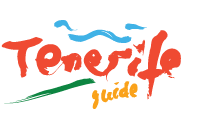Thor Heyerdahl was the first scientist to recognise the cultural importance of the six Chacona pyramids in the Valley of Guimar, Tenerife. He received an illustrated article from a local newspaper written by amateur observers who tried to call attention to the existence of the pyramds. However, local archaeologists ignored them as they assumed the pyramids were mere heaps of stone left by early Spaniards clearing the land.
But Heverdahl observed that:
1. Unlike the agricultural terraces around them, which were built from rounded boulders found in the soil, the pyramids were built from angular blocks quarried from lava flows.
2. The terraces are laid out precisely, horizontally and vertically, as if professionally done with strings, and every stone is turned with its flat side out.
3 Many corner stones are carefully squared, and where the bedrock emerges it is chopped off to match the walls.
4. The main pyramid complex (pyramids 2-4) with plazas was found to be astronomically oriented to sunset at the summer solstice.
5. Carefully built stairways ascend from a level plaza to the top of each pyramid, leading up to a flat summit platform covered with gravel. The stairs are always on the west wall, so that by ascending them a person will face the rising sun.
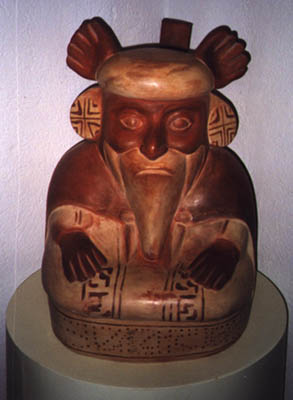 | 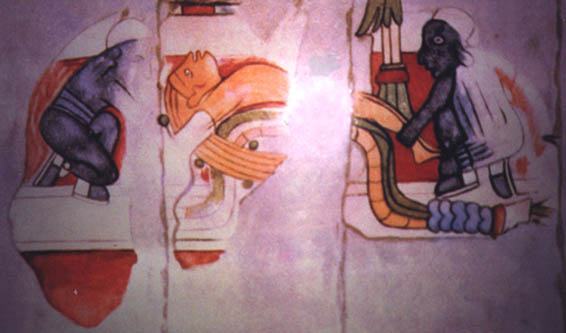 |  | 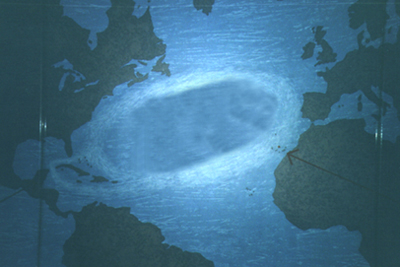 |
La Laguna University
Test excavations conducted by archaeologists from La Laguna University confirmed Heyerdahl’s conviction that these structures were architectural buildings built for ceremonial purposes by skilled stone masons studying the armual movements of the sun. Ongoing archaeological excavations reveal that an extensive cave underneath Pyramid I
served as a Guanche habitation.
In 1990 Heyerdahl’s old friend Norwegian ship owner Fred Olsen, offered to save the pyramids from destruction by financing a Culture Park and also an international archaeological research foundation (F.E.R.C.O.), which will receive all net income from the Park.
 | 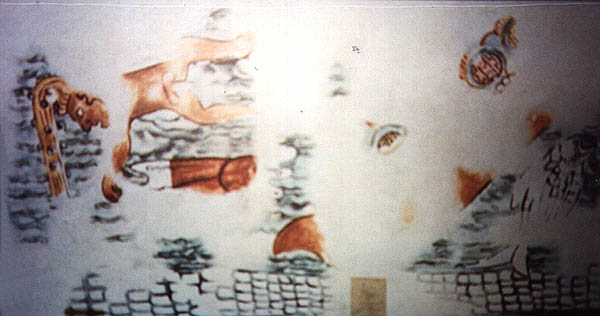 |  |  |
The Entrance.
a) Immediately inside the entrance, visitors will find the ticket office and the Plaza del Drago, where groups may assemble. The drago is a plant indigenous to the Canary Islands.
b) Passing on, visitors will see three paintings by the Swedish painter Per Lilliestrom. They illustrate how the Spaniards in 1492 were not permitted to land on Tenerife by the fairskinned and bearded Guanches and therefore they started their Atlantic crossing from the island of La Gomera, whereas in America the beardless aboriginal population received them everywhere as their ancestral gods.
c) Open view towards the east, showing pyramid 5 (on the left) and pyramid 6 (right).
d) Papyrus reeds, used by ancient North African civilisations for shipbuilding, and by Thor Heyerdahl in 1969 and 1970 to build Ra I and Ra II. Ra 11 crossed the Atlantic from Morocco to Barbados.
e) Casa Chacona Museum, one of the three oldest buildings in the Güimar Valley. Restored as a national heritage monument for exhibits of cultural parallels between the ancient civilizations of the Old and New Worlds.
 |  | 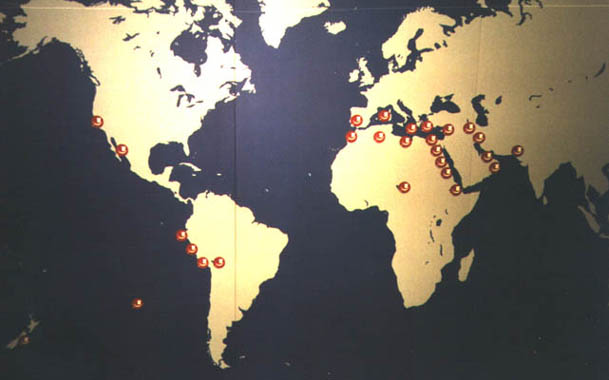 |  |
 |  |  |  |
The Museum
Inside the entrance, visitors will find a full-size replica by Marian Heyerdahl of the Tiahuanaco statue in Bolivia, representing the pre-Inca Sun God Kon Tiki. According to Inca traditions, this immigrant culture hero brought civilization to the Andes before he leR by rafi into the open Pacific. The Spanish Conquistador Pizarro was mistaken for him because of his beard.
The first room contains enlarged reproductions by Marian Heyerdahl of the bearded gods of Mexico and Peru, copied from originals found archaeological and now displayed in North and South American museums.
The second room displays a centrally placed map of the Atlantic with mobile currents. To the left are reproductions in paint and sculpture of fair-haired people coming ashore and being sacrificed by darker individuals, as illustrated its the pre-Columbian frescoes in the Temple ofthe Warriors at Chitzen Itza, on the Atlantic coast of Mexico.
To the right are fair-haired aboriginal of the Canary Islands (as illustrated in a water colour by Tomani) in 1590. Similarly fair-haired Africans are found among the Berbers and in early Roman frescoes and mosaic from Lixus, on the Atlantic coast of Morocco.
The third room displays models of reed boats and shows their dispersal in the ancient world, followed by models and world distribution of stepped pyramids.
 |  | 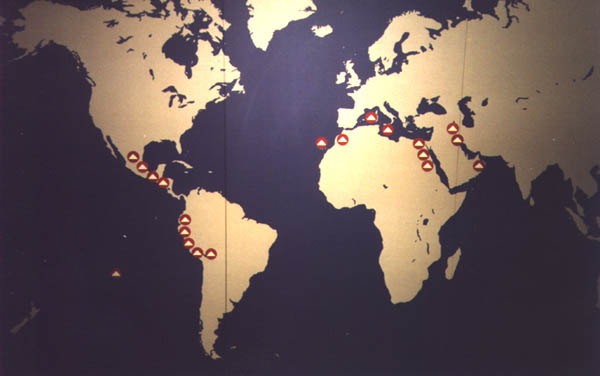 |  |
 |  |  |  |
The Panorama Terrace
f) On the way to the Panorama Terrace visitors will see a full-size replica of the papyrus reed ship Ra II, used by Thor Heyerdahl and his seven-man international crew to cross the Atlantic in 1970. The original is in the Kon Tiki Museum in Oslo, Norway together with the Kon Tiki raft.
g) Panorama Terraces with view of pyramids 2-4 as well as the ceremonial roads between pyramids.
h) Continuing down the ramp on the opposite side) visitors will find a stairway leading to the Auditorium) where they will see a 12-minute film with excerpts from Heyerdahl’s documentaries and which gives his reasons for experimenting with pre-European watercrail. The lobby contains an exclusive exhibit of reed boat models.
i) Leaving the Auditorium, visitors will turn right onto the ancient North-South Ceremonial Road and next turn leR at the cross-roads onto the East-West Ceremonial Road past the replica of Ra II. At the base of this Road, visitors will turn left onto a specially prepared tourist trail past the Guanche cave and Pyramid 1 and around Pyrarnids 1-4, which will bring them back to the same cross-roads.
From here they will proceed past Pyramid 5 and next Pyramid 6 which had its stairs covered by stone until they were discovered archaeological in 1997.
The visit ends at the leisure area, where you will find our Cafeteria and Souvenir Shop.
Architect of the park : Cesar luiz-Larrea (Madrid)
Surface of the Park: 65.000m2.
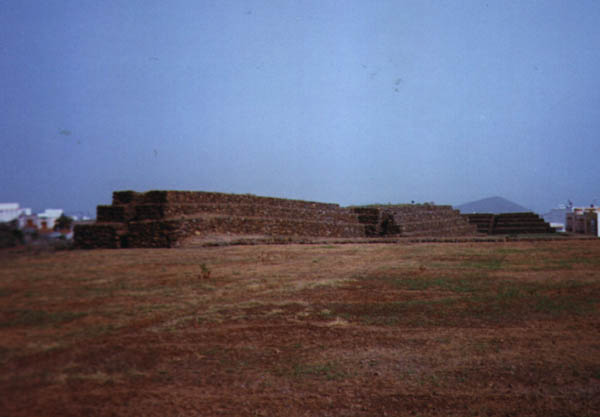 |  | 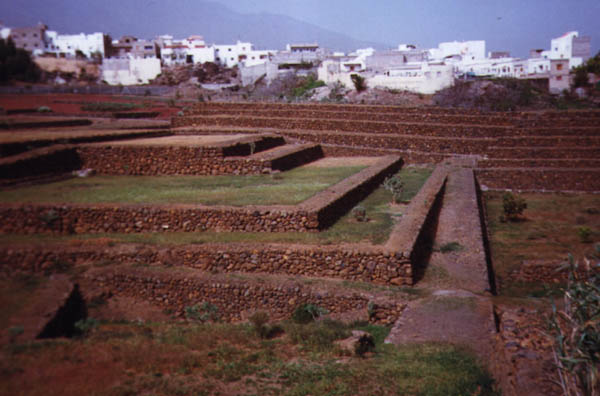 |  |
WE KINDLY ASK YOU NOT TO CLIMB ON THE PYRAMIDS!!!!
THE WAY TO PARQUE ETNOGRAFICO
Take the Highway TF1 North to Santa Cruz, after about 44 km turn right at exit Güímar and under the highway through viaduct up to village. Just follow the signs to the park.
From Santa Cruz it´s only 28 km South on Highway TF1 to Güímar.
At the first crossing when you have passed the Shell gas station there is signs you follow to the Parque Etnografico.

Tel: 00934-922-51 45 10.
E-mail: piramides@fredolsen.es

